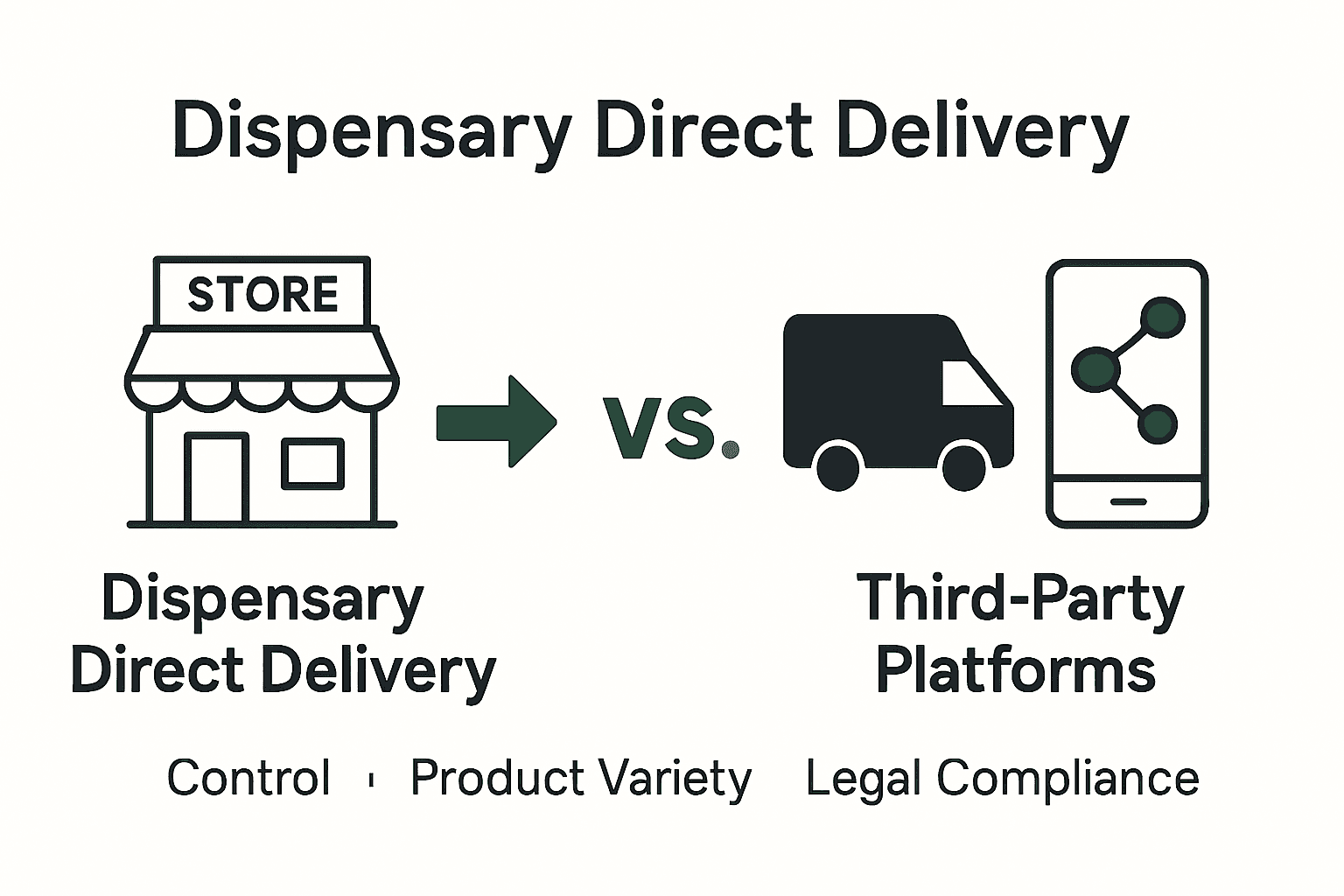
What Is Cannabis Delivery? Complete 2024 Guide
Over one third of cannabis consumers now prefer home delivery for its ease and privacy, reshaping the way people buy their favorite products. With demand at an all-time high, understanding how cannabis delivery works is more important than ever. This article breaks down everything you need to know about the digital platforms, legal rules, and safety factors that define this fast-growing service, helping you navigate your options with confidence.
Table of Contents
- Cannabis Delivery Explained And Core Concepts
- Types Of Cannabis Delivery Services
- How Cannabis Delivery Services Operate
- Legal Requirements For Cannabis Delivery
- Risks, Costs, And Customer Responsibilities
Key Takeaways
| Point | Details |
|---|---|
| Convenience of Delivery | Cannabis delivery provides a modern, efficient way for consumers to receive products at home, enhancing the purchasing experience. |
| Legal Compliance is Essential | Consumers must understand and comply with local regulations regarding cannabis delivery to ensure safe transactions. |
| Diverse Delivery Models | Delivery services can be categorized into dispensary direct and third-party platforms, each offering unique advantages and operational challenges. |
| Customer Responsibilities | Customers must actively verify their age, manage delivery fees, and ensure secure delivery locations to mitigate risks. |
Cannabis Delivery Explained And Core Concepts
Cannabis delivery represents a modern, convenient method for consumers to receive cannabis products directly at their doorstep, transforming traditional purchasing experiences. According to research from libres.uncg.edu, this service model has emerged as a critical component of cannabis entrepreneurship, reflecting evolving market dynamics and consumer preferences.
Cannabis delivery operates through specialized digital platforms that connect licensed dispensaries with customers, enabling seamless online ordering and direct home distribution. The process typically involves several key steps:
- Age verification for legal compliance
- Product selection from available inventory
- Secure online payment processing
- Scheduled delivery by verified drivers
- Contactless drop-off at customer’s specified address
The rise of cannabis delivery services represents more than just a transactional convenience. As explored in alternative distribution models like Cannabis Social Clubs, these platforms are reshaping how consumers access and interact with cannabis products. By providing discreet, efficient purchasing options, delivery services cater to individuals seeking privacy, accessibility, and a personalized shopping experience.
For consumers interested in exploring cannabis delivery, understanding local regulations is crucial. Legal requirements vary significantly between regions, impacting everything from permissible product types to delivery radius and verification protocols. Responsible platforms prioritize strict compliance, ensuring safe, legal transactions that protect both consumers and businesses.
Types Of Cannabis Delivery Services
Cannabis delivery has evolved into multiple sophisticated service models, each designed to meet diverse consumer needs and regulatory requirements. According to research from servd.flowhub.com, these models range from innovative “pizza-style” hub-and-spoke systems to more dynamic “ice cream truck” approaches, demonstrating the industry’s adaptability.
The primary cannabis delivery frameworks can be categorized into several distinct types:
- Dispensary Direct Delivery
- Operated entirely by a single licensed dispensary
- Products shipped from the store’s own inventory
- Highest level of quality control and compliance
- Third-Party Delivery Platforms
- Independent services partnering with multiple dispensaries
- Provide technology and logistics infrastructure
- Offer broader product selection for consumers
As detailed by medium.com, these delivery frameworks each present unique benefits and challenges. Vertically integrated services offer seamless control, while third-party platforms provide greater flexibility and market reach.

Consumers can explore delivery options like Flower products that suit their specific preferences, understanding that local regulations significantly impact available delivery models. The key is finding a service that balances convenience, product quality, and strict legal compliance.

How Cannabis Delivery Services Operate
Cannabis delivery services have developed a sophisticated operational process that prioritizes convenience, compliance, and customer experience. According to marijuanaindex.com, the typical delivery journey involves several critical stages designed to ensure a seamless and legally compliant transaction.
The operational workflow of cannabis delivery services typically follows these key steps:
- Online Product Browsing
- Customers explore digital product catalogs
- Detailed strain information and pricing displayed
- Real-time inventory updates
- Verification and Authentication
- Strict age verification process
- Government ID scanning
- Compliance check against local regulations
- Order Processing
- Payment confirmation
- Inventory allocation
- Delivery scheduling
Drawing insights from Wikipedia’s SpeedWeed overview, many services operate through centralized hub systems that streamline order processing and logistics. These platforms leverage technology to manage complex regulatory requirements while maintaining efficient delivery mechanisms.
Customers interested in exploring premium options might want to check out our Shipping Policy to understand delivery parameters and expectations.
Ultimately, successful cannabis delivery hinges on balancing technological innovation, strict regulatory compliance, and customer-centric service design.
Legal Requirements For Cannabis Delivery
Navigating the legal landscape of cannabis delivery is complex and nuanced, with regulations varying dramatically across different jurisdictions. According to research from libres.uncg.edu, comprehensive legal frameworks govern every aspect of cannabis delivery, from initial licensing to final product distribution.
Key legal requirements for cannabis delivery services typically include:
- Licensing Criteria
- State-specific business licenses
- Cannabis distribution permits
- Ongoing compliance documentation
- Regulatory Compliance
- Age verification protocols
- Product tracking systems
- Strict inventory management
- Operational Restrictions
- Limited delivery zones
- Quantity purchase restrictions
- Secure transportation guidelines
Drawing insights from Wikipedia’s analysis of cannabis commodification, the legal environment continues to evolve, reflecting changing societal attitudes and regulatory approaches. Delivery services must remain agile, adapting to new legislation and maintaining meticulous compliance standards.
For consumers and businesses alike, understanding these intricate legal requirements is crucial. Platforms like our FDA Disclaimer provide additional context about the regulatory landscape, helping stakeholders navigate the complex world of cannabis delivery with confidence and legal awareness.
Risks, Costs, And Customer Responsibilities
Cannabis delivery services require active participation and understanding from customers to ensure a safe, legal, and smooth transaction. According to marijuanaindex.com, customers bear significant responsibilities throughout the delivery process, extending far beyond simply placing an order.
Customer Responsibilities encompass several critical areas:
- Legal Compliance
- Verify personal age eligibility (21+)
- Understand local cannabis regulations
- Possess valid government-issued identification
- Maintain legal possession limits
- Financial Considerations
- Understand delivery fees
- Budget for potential additional charges
- Prepare acceptable payment methods
- Factor in potential taxes
- Safety and Risk Management
- Be present during delivery
- Provide secure delivery location
- Protect delivered products from unauthorized access
- Maintain discreet product storage
Potential risks in cannabis delivery include potential legal complications, delivery delays, product quality variations, and privacy concerns. Consumers must proactively manage these risks by staying informed, maintaining clear communication with delivery services, and understanding their local regulatory landscape.
Customers interested in a comprehensive understanding of potential financial implications might want to review our Refund Policy to fully comprehend their rights and responsibilities. Ultimately, successful cannabis delivery requires a collaborative approach between service providers and informed, responsible consumers.
Discover the Convenience of Cannabis Delivery with Grade A Dropouts
Understanding the details and legalities of cannabis delivery can feel overwhelming. This article breaks down key challenges like age verification, compliance, and safe product handling so you can shop confidently. If privacy, accessibility, and quality control are important to you, finding a trusted delivery service that meets those needs is essential. At Grade A Dropouts, we simplify this process by offering premium THC strains sourced from trusted growers in Oregon, California, and Washington with secure online ordering and free delivery on orders over $200.

Explore our Uncategorized – Grade A Dropouts collection and experience a seamless cannabis delivery that prioritizes your safety and satisfaction. Don’t wait to elevate your cannabis experience with our reliable service and detailed product descriptions backed by real reviews. Visit Grade A Dropouts now and take advantage of expert-curated strains designed for natural healing and relaxation.
Frequently Asked Questions
What is cannabis delivery?
Cannabis delivery is a service that allows consumers to receive cannabis products directly at their doorstep through digital platforms that connect licensed dispensaries and customers.
How does the cannabis delivery process work?
The cannabis delivery process typically involves online product browsing, age verification, secure online payment, order processing, and scheduled delivery by verified drivers, ensuring compliance with local regulations.
What types of cannabis delivery services are available?
Cannabis delivery services can be categorized mainly into two types: dispensary direct delivery, which is operated by individual licensed dispensaries, and third-party delivery platforms that partner with multiple dispensaries for a broader product selection.
What are the legal requirements for cannabis delivery services?
Legal requirements for cannabis delivery services often include obtaining state-specific business licenses, adhering to age verification protocols, ensuring product tracking, and adhering to specific operational restrictions like delivery zones and quantity limits.
